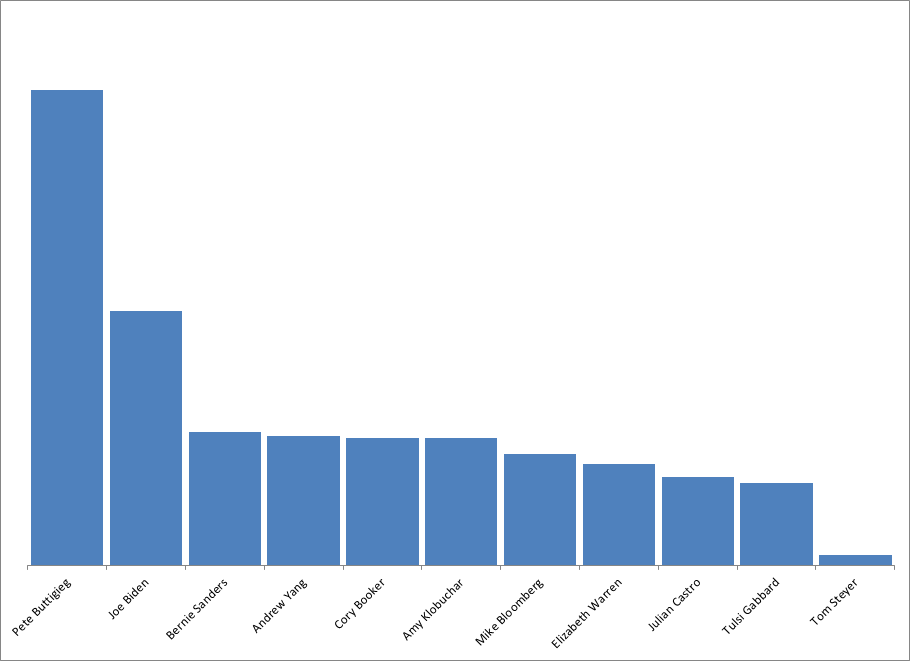Summary
Using our First Impression Score (FIS), which measures social media’s reaction to the respective candidate’s announcement of running for the Democratic nomination, Mike Bloomberg looks like a candidate who has the potential to make an impact.
However, Bloomberg’s FIS only places him around the middle of the pack implying his announcement was greeted with a mediocre level of interest — not great not terrible, just ok. This is not the type of numbers we expect from a late entrant looking to serve as a savior to a weak field.
A mediocre FIS, especially this late in the campaign, implies Bloomberg will fight an uphill battle.
How Bloomberg Compares
FIS is taken around the time of the candidate’s announcement. So, Bloomberg’s was just recently taken whereas most were measured in the first semester, in other words around each respective announcement.
Chart 1: Social Media First Impression Score (FIS) of Main Democratic Candidates

Source: ZettaCap
Bloomberg comes in around the middle of the pack. Certainly, this does not disqualify him from gaining in the polls or making a considerable impact on the race. It does show, however, that social media did not greet his announcement with much fanfare. The bottom line is that Bloomberg can still gain but it will be an uphill battle.
Our current understanding based on our data is that there is an opening for a new strong entrant in the Democratic nomination as no single candidate has been able to pull ahead for any significant period of time, which for this stage is somewhat concerning. This creates a opportunity for a ‘savior’ candidate to come into the race, even at a late stage, and still be successful.
In such a scenario, we would expect that ‘savior’ candidate to make an impressive splash (meaning strong FIS) upon announcement as it would generate considerable interest and excitement.
Bloomberg’s mediocre FIS tells us that he is not the natural ‘savior’ that we believe many are open to receiving.
Could he still become the nominee? Perhaps. But, without a big initial splash, the chances of him being seen more as a spoiler than a savior have increased sharply.
First Impression Score (FIS) / How Social Media Initially Reacts
Our preferred metric for election forecasting is our Social Media Influence (SMI) for longer-term analysis. However, to determine the potential of a candidate at the beginning of a campaign it is often better to look at Social Media First Impression Score (FIS). This indicator uses social media data to measure the initial impact of an event, such as a campaign announcement.
FIS is a measure that can be easily and intuitively understood. The basic idea is that immediate reactions to certain events (like a new product announcement or a politician’s campaign announcement) are indicative of their later success. Significant early traction on social media indicates later success whereas meager early traction indicates a potential flop. This concept is fairly well tested and has been applied to how initial movie trailer buzz can forecast the movie’s box office.
Applying a similar concept to political campaigns has offered some impressive yet mixed results. For instance, Donald Trump’s campaign announcement resulted in a tremendous FIS which clearly indicated the potential of his candidacy. Also during the 2016 election cycle, Bernie Sanders did not produce such an impressive FIS, but instead gained traction over time resulting in an impressive SMI. The point is that a large initial splash in terms of FIS can be indicative but it is not necessarily a make or break for a candidate.
The combination of a relatively unknown candidate producing an impressive FIS implies the candidate could be a dark horse or a sleeper candidate – one that will surprise. This was the case with Pete Buttigieg.
The combination of a nationally known candidate producing a strong FIS signals a naturally strong candidate. This was the case with Joe Biden.
Not a Perfect Indicator of Success (but pretty good)
Like most indicators, FIS has a bias. Some candidates simply do not focus that much on their announcement whereas others make sure they hit the ground running. So, there are other factors involved and not just which is the potentially stronger candidate. FIS is clearly biased in favor of those candidates who focus on the announcement.
Kamala Harris, who just recently exited the race, produced an impressive FIS. Her announcement was well coordinated and planned, including a large and supportive rally, a media blitz, and a build-up (teasers to an important announcement). And, for a time, Harris looked like she could become the front-runner. For about six months, FIS did an exceptional job of forecasting her potential as a candidate as she gained in the polls and even lead in betting markets for a time.
FIS, however, cannot forecast a campaign’s eventual success, just if people are initially open to it in the first place. In Kamala’s case, her strong FIS showed that the electorate was very open to her candidacy and she obtained relatively easy traction.
In Bloomberg’s case, his mediocre FIS shows us that people are moderately open to his candidacy. Such a level would have been fine if it occurred early in the race, like in the 1Q or 2Q. However, as his announcement comes in the 4Q, the fact that his FIS is only average does not paint an optimistic picture for him. Time is playing against Bloomberg at this stage and a minor announcement splash plays against him.